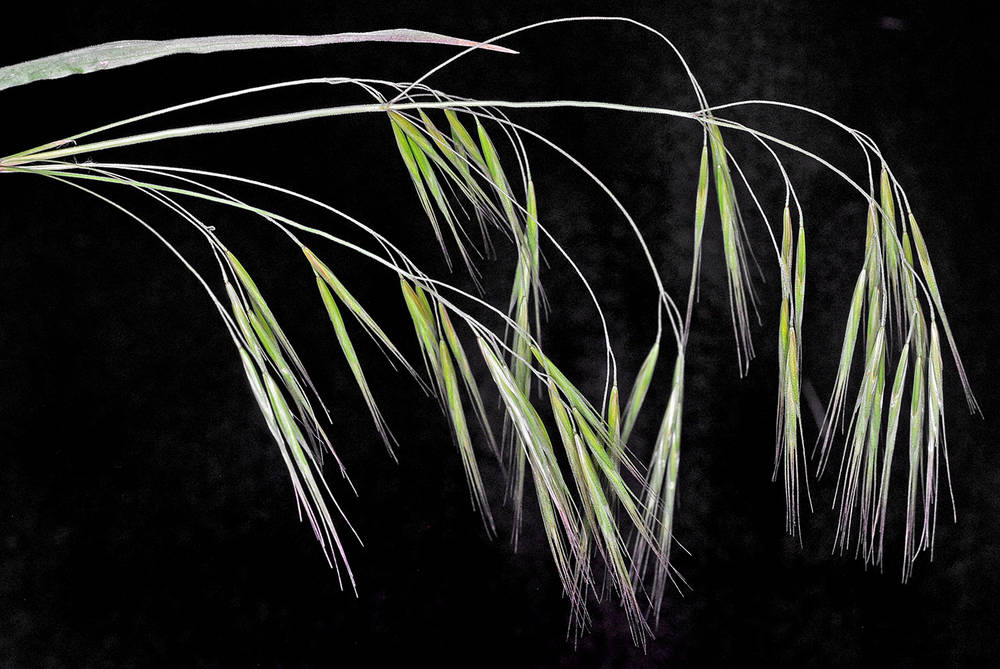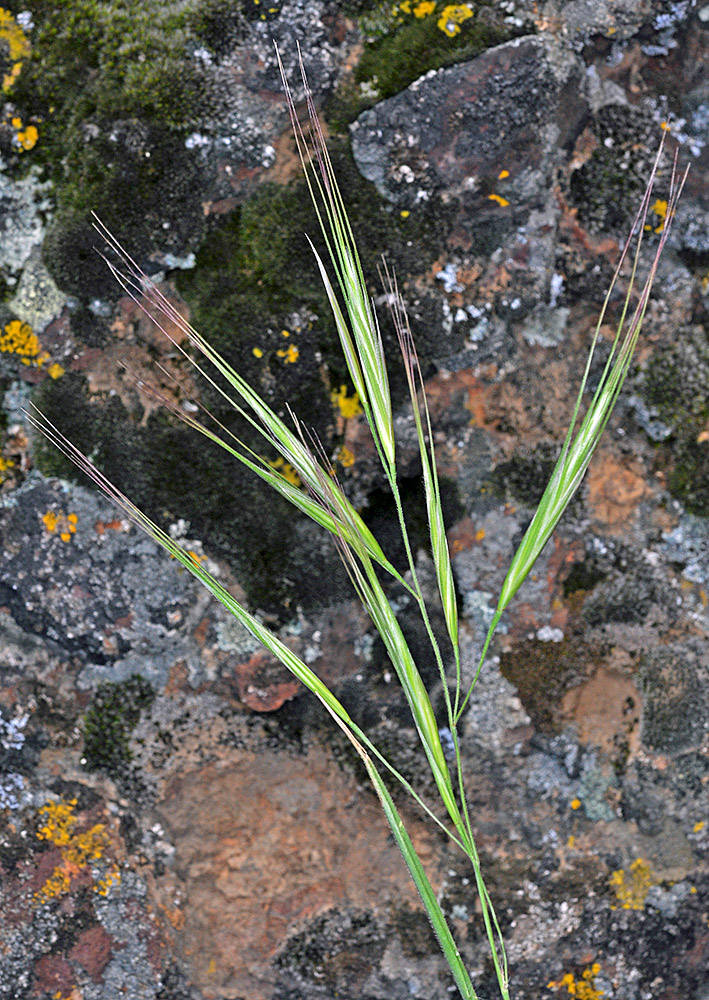Bromus tectorum
Bromus diandrus
cheatgrass, downy brome, downy chess
ripgut brome
puberulent.
puberulent.
sheaths densely and softly retrorsely pubescent to pilose; upper sheaths sometimes glabrous;
blades 1–16 cm × 1–6 mm, softly hairy on both surfaces.
sheaths softly pilose, often with retrorse or spreading hairs;
blades 3.5–27 cm × 1–9 mm, pilose on both surfaces.
5–20 × 3–8 cm; open, nodding;
branches 1–4 cm, drooping, 1-sided and longer than the spikelets, usually at least 1 branch with 4–8 spikelets.
panicles 13–25 × 2–17 cm, nodding at maturity but occasionally erect;
branches 1–7 cm, stiffly erect to ascending or spreading, 1–2 spikelets.
10–20 mm, moderately laterally compressed, not densely crowded, 4–8 florets.
25–70 mm, moderately laterally compressed, with 4–11 florets.
villous, pubescent, or glabrous;
lower glumes 4–9 mm, 1-veined;
upper glumes 7–13 mm, 3–5-veined.
smooth or scabrous;
lower glumes 15– 25 mm, 1–3-veined;
upper glumes 25–35 mm, 3–5-veined.
9–12 mm, lanceolate, glabrous or pubescent to pilose, 5–7-veined;
tips acuminate; hyaline; bifid, with teeth 0.8–2(3)mm, awned;
lemma awns 10–18 mm; straight.
22–30 mm, linear-lanceolate, scabrous, 7-veined;
margins hyaline;
tips acuminate; bifid;
teeth 3–5 mm, awned;
lemma awns 30–65 mm; straight.
0.5–1 mm.
0.5–1 mm.
=14.
=28, 42, 56.
Bromus tectorum
Bromus diandrus
Disturbed areas, sagebrush steppe, degraded grasslands, roadsides. 0–2400 m. BR, BW, Casc, Col, CR, ECas, Lava, Owy, Sisk, WV. CA, ID, NV, WA; throughout North America; worldwide. Exotic.
Bromus tectorum is a relatively short grass with drooping inflorescences. Similar B. sterilis and B. diandrus have longer glumes, lemmas, and awns, and spikelets that hang down at a shallower angle than those of B. tectorum. The introduction of B. tectorum to shrub steppe habitats during a time of massive overgrazing in the late 1800s has made restoration of native plant communities difficult or impossible, even where grazing no longer occurs. Fast-growing B. tectorum seedlings outcompete slower growing native grass seedlings for water in drying soils. At maturity, the awns make B. tectorum unpalatable to livestock.
Disturbed open areas, degraded grasslands. 0–1300m. Col, CR, ECas, Est, Lava, Sisk, WV. CA, ID, NV, WA; north to British Columbia, southeast to TX, south to Mexico, scattered in the eastern US; Europe. Exotic.
Bromus diandrus is a common weed, typically with gracefully curved inflorescences and long lemma awns. The long awns can lodge in the mouths and digestive tracts of herbivores, causing injury. Similar B. sterilis is smaller in all its parts.
Barbara Wilson, Richard Brainerd, Nick Otting
Barbara Wilson, Richard Brainerd, Nick Otting
- Local floras:
BC,
CA,
OR,
WA
- Local Web sites:
CalFlora,
CalPhotos,
Flora NW,
PNW Herbaria
WildflowerSearch
iNaturalist (observations)
USDA Plants Database
- LBJ Wildflower Center
- SEINet
- Plants of the World Online
- Encyclopedia of Life
- Wikipedia
- Google Image Search
- Local floras:
CA,
OR,
WA
- Local Web sites:
CalFlora,
CalPhotos,
Flora NW,
PNW Herbaria
WildflowerSearch
iNaturalist (observations)
USDA Plants Database
- LBJ Wildflower Center
- SEINet
- Plants of the World Online
- Encyclopedia of Life
- Wikipedia
- Google Image Search





